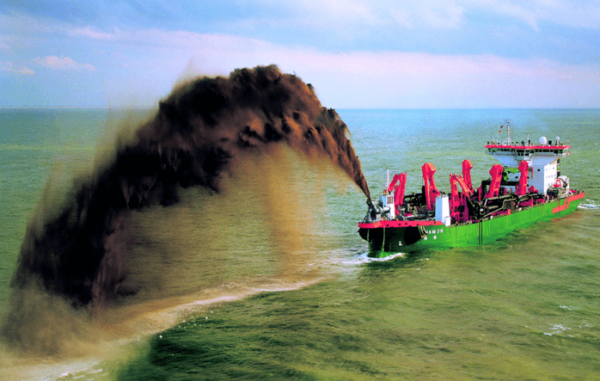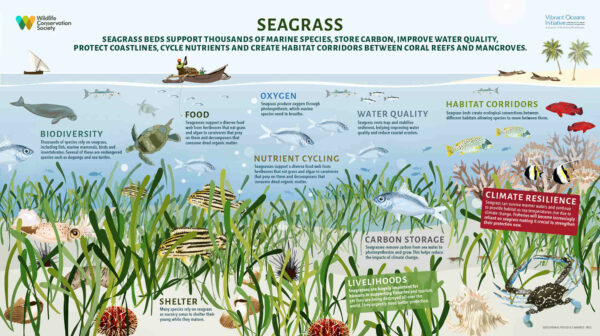Environmental Impacts of Dredging on Seagrass Habitats – Part 2
Coty Perry – YourBassGuy.com
A worldwide study showed in 45 cases, a total loss of 21,023 hectare (or general surface area) of seagrass due to dredging.
Seagrass serves as an ecosystem, a food, and a home to many high risk marine species. Dredging, maritime activities, and various enterprises of man contribute to the death of aquatic ecosystems every day.
The interesting thing about dredging is that it’s actually designed to improve water quality, but do the positive effects outweigh the negative impact it has along the way?
What is Dredging and Why is it Required?
Dredging is the process of removing silt and other materials from the bottom of water bodies. It’s primarily used in ports and areas where ships are moving in and out.
Removing sediment and debris from the bottom of rivers and harbors helps prevent the water channels from becoming overly contaminated and clogged.
The primary goal is to maintain proper depth of the channels and berthing areas so vessels can comfortably pass through. They require a certain amount of water depth to float without concern over touching the bottom.
One significant factor that is often overlooked is how this process impacts marine life as well as the overall aquatic ecosystem. In many cases, seagrass and water vegetation is removed during this process. While dredging is also designed to improve water quality for marine life, it can have an adverse effect.
Seagrass can only withstand so much sedimentation and turbidity before it becomes damaged and ultimately, lost. As a result, post-dredging studies show that seagrass grows faster once water quality returns to normal.
How do Ports Know When to Dredge?
When high turbidity is determined is when ports know it’s time to dredge. There are a set of parameters used to determine how polluted the water is by measuring the level of turbidity using sensors.
These sensors measure the overall cloudiness of the water to indicate the overall water quality. While natural factors such as storms and currents can cause turbidity, man-made factors like construction and maritime activities are the main contributors.
By keeping a close eye on turbidity and promoting strict regulation, ports are able to dredge the water, improve the conditions, and do so without doing too much harm to the aquatic ecosystem.
What are Major Threats to Seagrass Beds?
While we think of coral reefs being the primary at-risk habitat, seagrass beds are equally important.
Climate change, habitat degradation, and rising sea levels are all major threats to seagrass populations. These flowering marine plants are incredibly important for passing off nutrients and organic matter into the water. These flowers serve as an important habitat for juvenile fish and fauna while also providing a place for endangered turtles and manatees to graze.
Sedimentation is the main method of maintaining the quality of seagrass beds but unfortunately, without strict regulation, it could actually have a stranglehold on the marine population as well as the vegetation.
The high turbidity in the water post-dredging reduces the amount of oxygen in the water and further spreads pollution throughout the ecosystem.
How the Timing of Dredging Impacts Seagrass Recovery
There is a very precise window for performing dredging to minimize its negative impact and maximize its positive impact.
A study performed by QUT researchers showed that areas of high-stress tend to have higher turbidity. As a result, those areas should be left alone because the seagrass is not receiving ample light to allow it to thrive.
Areas of extended calm periods tend to have less turbidity and as a result, the seagrass has been consistently receiving ample light. These areas could benefit from dredging as long as it’s done carefully and under strict regulation.
Being able to tell the difference between a site where you can do some dredging and seagrass will come back, a site that is at its limit and you shouldn’t do any more to it, or a site that’s already dying and it doesn’t make a difference what you do to it, is very important
– Dr Wu
Seagrass Habitat Restoration Techniques
The ultimate question then becomes, how can we help restore the seagrass population in areas where it has been stressed to the point of no return?
Improving water quality and transplanting from healthy beds are two of the main ways to make this a reality.
The first method of improving water quality states that providing improved conditions will allow seagrass to naturally colonize. Regulating sewage systems and limiting maritime activities are two ways to improve conditions without the need for dredging.
With awareness, activism, and proper implementation, we can make a difference in the seagrass population. It’s a more important topic than most think because it is a staple of the aquatic ecosystem and serves as a home to many sea creatures.




